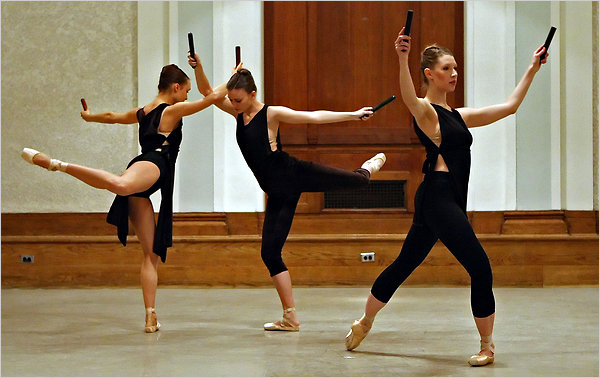Why hasn’t Miro Magloire been offered more opportunities in the ballet world? Companies, after all, are always looking for new talent, and Mr. Magloire creates clean, contemporary work that also has an old-fashioned respect for ballet steps and etiquette.
Blog
But somehow Mr. Magloire, who presents his New Chamber Ballet a handful of times a year at Studio 4 in City Center, seems to remain in his own self-contained world. It’s a slightly austere one, in which live music — usually piano and violin — and dance are scrupulously presented in notably nontheatrical surroundings. The lights are cruelly bright, there is no scenery and no wings for the dancers to disappear into or emerge from. (There are, however, minimal but imaginative costumes, usually by Candice Thompson, and the dancers are always immaculately groomed.)
It’s this bare-bones approach that permits New Chamber Ballet to perform as often as it does and allows Mr. Magloire to commission work from others. But one result, despite Mr. Magloire’s adventurous musical spirit (he was a composer before turning to dance), is a sameness about his brief seasons, the latest of which opened on Friday.
The limitations of the studio context felt immediately severe in the first piece, Emery LeCrone’s new “Virtuosa,” set to Saint-Saëns’s Violin Sonata No. 1 in D minor. A solo danced by Alexandra Blacker, it would probably have looked better with some dramatic lighting and at more distance. Up close in the unforgiving light it was hard to get any sense of structure or pacing in the solo, which deployed a conventional ballet vocabulary and a brightly presentational mien that didn’t feel terribly responsive to, or revealing of, the vivid, turbulent score (beautifully played by Erik Carlson and Steven Beck).
It was followed by Mr. Magloire’s new “Night Music,” a trio performed (by Madeline Deavenport, Katie Gibson and Lauren Toole ) in silence except for the sounds of claves — small wooden sticks used by percussionists — that the dancers intermittently knocked together. The effect was intriguingly mysterious, and Mr. Magloire’s sculptural, angular groupings and deliberate, testing encounters had arresting moments.
But “Night Music” never quite achieved focus or momentum, and this is true of much of Mr. Magloire’s work. It’s clearly and meticulously made, but you long for a moment of madness, or at least intensity. There is a little of that in “Klavierstück,” the best piece he has choreographed since I’ve been watching the company.
Set to Stockhausen’s “Klavierstück IX” — now pounding, now delicately lyrical — the ballet creates strange, potent images of the relationship among the dancers, the pianist and the piano. Here Mr. Magloire’s meticulous, deliberate vocabulary sets up an odd and compelling tension with the passionate discordance of the music.
There wasn’t much compelling about Constantine Baecher’s rather limp “Sketches of a Woman Remembering,” the final of three premieres on the program and set to three Debussy Preludes from Book 1. The work’s premise is that the nymph solicited in Nijinsky’s “Afternoon of a Faun” recalls her rejection of the faun with regret, and it offers solos to three women (Ms. Blacker, Ms. Toole and Victoria North), each draped in a long chiffon cloak and apparently equally miserable about this lost opportunity.
It’s all pleasant enough in a drifty, chiffonish sort of way. But it’s a bit of a disappointment coming from Mr. Baecher, who has offered New Chamber more muscular and less sentimental work in the past.
The New Chamber Ballet appears on March 16, with Ben Munisteri and Michele Wiles, at the Museum of Arts and Design in Manhattan; madmuseum.org.


Leave A Comment
You must be logged in to post a comment.